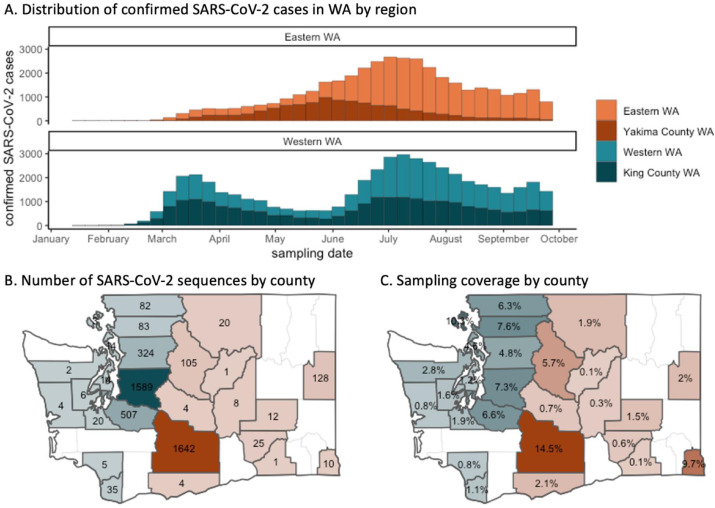Genetic analysis of SARS-CoV-2 indicates role of inter-state travel on transmission in Washington
The first confirmed SARS-CoV-2 infection in North America was identified in Washington State (WA) in January 2020. Since then, there have been nearly 500,000 confirmed cases throughout WA. In a recent study published in The Lancet Regional Health – Americas, researchers investigated the role of introductions of SARS-CoV-2 in WA and their geographic source using publicly shared genomic data from December 2019 through September 2020.
This first of its kind large-scale phylogenetic analysis of regional SARS-CoV-2 transmission patterns, estimates that the vast majority introductions of SARS-CoV-2 into Washington originated from elsewhere in the United States, and also reflected a significant amount of intra-state transmission between the eastern and western regions of WA.

“Phylogenetics uses a whole genome or part of the genome of a virus from a collection of DNA or RNA to reconstruct a family tree, or what we call a phylogenetic tree, that represents the evolutionary relationships between the viruses,” explained the study’s lead author, Diana Tordoff, doctoral student in the UW Department of Epidemiology. “In this case, we used a specific method called ancestral state reconstruction to estimate the number of SARS-CoV-2 import, or ‘introductions’, and export events over a ten-month period.”
The team conducted molecular epidemiologic analysis of 11,422 publicly available whole genome SARS-CoV-2 sequences from GISAID. They estimated a minimum of 287 introductions into Washington State, 61 percent of which likely originated from elsewhere in the US, while the remaining 39 percent reflected transmission from outside the US. Introductions began in mid-January and peaked on March 29, 2020. Notably, both introductions and exports fell within the week of the “Stay Home, Stay Healthy” order went into effect, which required Washingtonians to remain home and restricted unessential travel.
They also observed a significant amount of intra-state SARS-CoV-2 transmission, with a large number of introductions from western into eastern WA, which is geographically divided by the Cascade Mountain range. However, there were conversely fewer introductions from eastern to western WA, indicating asymmetrical transmission patterns.
“These types of analyses can be helpful in clarifying what types of public health measures are effective to immediately reduce introductions,” explained Tordoff. “While we looked at the geographic patterns of the virus relatively early in the pandemic, our findings foreshadowed what we’re seeing now, with the new waves of variants that quickly travel to new geographies.”
Although this study found there were frequent introductions of new viral lineages, they only accounted for 5 to 7 percent of the total number of cases. Most introductions don’t result in long chains of transmission, and most cases of SARS-CoV-2 in Washington are due to local and community-based transmission.
The SARS-CoV-2 genome is long, with over 30,000 base pairs, which can make this type of phylogenetic sequencing computationally challenging. “One of the strengths of this analysis is that we used a large number of sequences, and we used robust methods to estimate the uncertainty of our estimates,” described Tordoff.
Dr. Joshua Herbeck, infectious disease epidemiologist and assistant professor, UW Department of Global Health, shared that, “while this research helps us quantify SARS-CoV-2 introductions in Washington, these results can also be valuable in further mathematical modeling to predict how SARS-CoV-2 and other viruses may be introduced into a particular community and effective measures to slow the spread.”